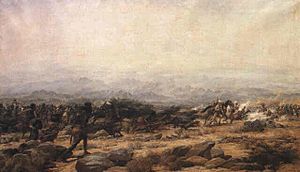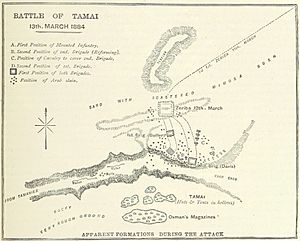Battle of Tamai facts for kids
Quick facts for kids Battle of Tamai |
|||||||
|---|---|---|---|---|---|---|---|
| Part of the Mahdist War, 1881–1899 | |||||||
 An incident at the Battle of Tamai, eastern Sudan, 13th March, 1884 by Godfrey Douglas Giles |
|||||||
|
|||||||
| Belligerents | |||||||
| Commanders and leaders | |||||||
| Sir Gerald Graham | Osman Digna | ||||||
| Strength | |||||||
| 4,500 troops 22 field guns 6 machine-guns |
10,000 troops | ||||||
| Casualties and losses | |||||||
| 214 killed or wounded | 4,000 killed or wounded | ||||||
The Battle of Tamai was a big fight that happened on March 13, 1884. It was between soldiers from the United Kingdom (Britain) led by Sir Gerald Graham and a Sudanese army. This Sudanese army was part of a group called the Mahdists, and their leader was Osman Digna.
Even though the British had won a battle before, called El Teb, General Graham knew that Osman Digna's army was still strong. He also knew that many local people supported Osman Digna. So, a second British army left Suakin on March 10 to try and defeat the Mahdists for good.
The British army had about 4,500 soldiers, with 22 cannons and 6 machine guns. The Mahdist army was larger, with about 10,000 fighters. Most of these fighters were from the Hadendoa tribe. British soldiers sometimes called them "Fuzzy Wuzzies" because of their unique hairstyles.
Who Fought at Tamai?
The British forces involved in this battle included:
- Soldiers from the 10th Hussars and 19th Hussars (cavalry units)
- Infantry (foot soldiers) from famous regiments like The Black Watch (Royal Highlanders) and The King's Royal Rifle Corps
- Other infantry units like the York and Lancaster Regiment, Gordon Highlanders, and The Royal Irish Fusiliers
- Royal Marines Light Infantry
- Sailors from the Royal Navy Naval Brigade
- Artillery units that used cannons
The Battle Begins
On the night of March 12, the British army set up their camp close to where Osman Digna's forces were. From about 1:00 AM until morning, Mahdist fighters with rifles came near the camp and started shooting. However, their aim wasn't very good, and they didn't cause many injuries.
When the sun came up, the British used their cannons to push the Mahdist fighters back. Then, the British infantry (foot soldiers), including the Black Watch regiment, formed into two large squares. These squares were like moving forts made of soldiers. One square was led by Colonel Davis and General Graham, and the other by Colonel Buller.
A small group of scouts found that the main Mahdist army was hiding in a deep valley, called a ravine, nearby. General Graham ordered the Black Watch to charge into the ravine to clear out the Mahdists. This charge left a big gap in their square formation. Suddenly, many Mahdist fighters rushed into this open space.
The Black Watch soldiers found themselves in a very tough fight against the Sudanese. The square was filled with charging tribesmen, and a fierce hand-to-hand combat began. The Black Watch fought bravely and eventually pushed the Sudanese out, then quickly reformed their square.
Other British units were in danger of being surrounded, so they had to fall back for a moment. But they quickly got back into formation. The Mahdist attack was stopped by gunfire from the other British square (Buller's square), which had stayed strong. Also, cavalry soldiers who had gotten off their horses joined the fight. Their combined fire caused many casualties among the Mahdists, forcing them to retreat.
The British soldiers then regrouped and continued their advance. They drove the Mahdists out of the ravine, causing more losses as they ran away. Osman Digna's camp was captured later that day, but Osman Digna himself managed to escape.
After the Battle
During the Battle of Tamai, the British army suffered more losses than in any other battle of the Mahdist War. About 214 British soldiers were either wounded or killed. The Mahdists also suffered heavily, losing around 4,000 fighters.
Two British soldiers showed amazing bravery during the battle and were given the Victoria Cross. This is the highest award for bravery in the British Army. They were Private Thomas Edwards of the Black Watch and Lieutenant Percival Marling of the King's Royal Rifle Corps.
The British hoped that this big defeat would weaken Osman Digna's power and influence over the Hadendoa tribe. However, this didn't happen. Later that year, when General Graham's army left Sudan, Osman Digna slowly regained his strength and influence. Because of this, Graham's campaign was seen more as a way to punish the Sudanese and restore British military pride, rather than a lasting victory.



